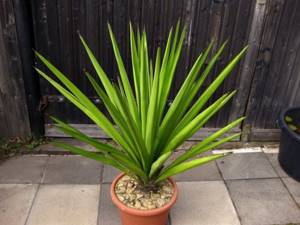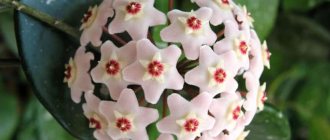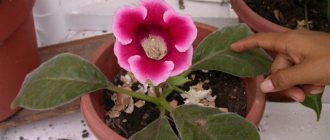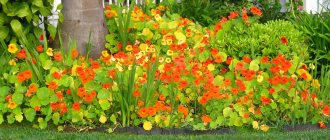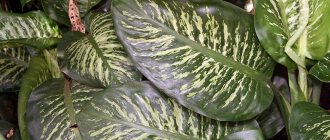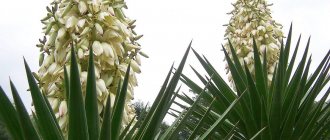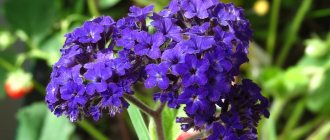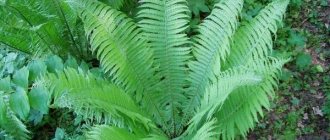Appearance and varieties of Yucca
The plant belongs to the lily family, but some classify it as an asparagus family. Appearance: Small indoor palm tree. This is a tree crop. The trunk is hard and thickened. It grows no more than 1 m if the species is a houseplant. Leaves:
- green;
- bright;
- rigid and flexible.
Often reminiscent of cordyline or dracaena leaves. Their length reaches 70-100 cm, they are collected in bunches on the branches of the trunk and at the top. Sometimes stemless species of this plant are found. at the top there are 3-4 rosettes of leaves directed straight up.
There are many species of Yucca in nature. Some names that can be grown at home are:
- Elephant;
- Filamentous;
- Aloe leaf;
- Gray;
Please note! In urban home conditions, Yucca Elephant and Aloe leaf are grown. The planting is identical, but you will have to care for it differently.
Elephant has the following inherent qualities:
- powerful base reminiscent of an elephant's leg;
- unpretentious plant, with standard care standards;
- suitable for small spaces.
Aloe leaf is less commonly grown at home, since caring for it requires preparation and not everyone can handle it. Other varieties of indoor Yucca are shown in the photo, but they are rarely grown.
Description of Yucca varieties
There are approximately 40 known varieties of yucca. Some of them are real “giants”, and in the wild their height exceeds 7–8 meters, others have more modest dimensions. Species differ in their distribution area, leaf length and other details.
Yucca gray
Gray yucca reaches a height of 2 meters. She comes from the west coast of the states. The leaves are 60 cm long, and their leathery surface is green with a blue tint. They are collected in volumetric sockets. The height of the flowering panicle is 1 meter.
Yucca gray
Yucca rostrata
This yucca is also called beak-shaped. It is distinguished by a thick trunk, on which traces of already dead leaves are clearly visible, which makes it especially similar to a palm tree. At the end of the stem there is a rosette of long lancet-shaped leaves. This is a large species, so it is recommended to grow it in large areas (living rooms, halls) or in a winter garden, where the yucca can shoot an arrow strewn with dozens of white bells. An unusual variegated variety has been developed, in which the edges of the leaves are decorated with stripes.
Also read: Streptocarpus: description of species and care recommendations
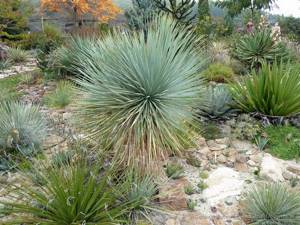
Yucca rostrata
Yucca radiata
The second name of Yucca radiata is tall, because in nature it is a real tree taller than 7 meters. The leaves, gradually tapering towards the base, are located very close to each other, and their white edges are often covered with thin threads.
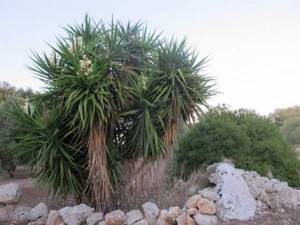
Yucca radiata
Yucca Schidigera
This is a large rosette in which long leaf plates are collected. It blooms with white bells located on a powerful shoot-peduncle. This type of yucca is used for the manufacture of medications in pharmacology and veterinary medicine. The substances that make up the plant have a beneficial effect on the functioning of the gastrointestinal tract and immune system.
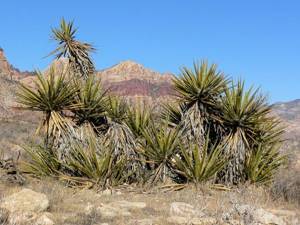
Yucca Schidigera
Yucca shortifolia
Short-leaved or tree-like yucca is also called giant. Its homeland is Arizona and the southern part of California, where this plant grows up to 9 m, and the diameter of the thick trunk is 50 cm. Closer to the top, such an exotic tree begins to branch. The dense leaves are not long - no more than 3 cm, have thorns and denticles along the edge. It is unlikely that short-leaved yucca can be grown in the rooms of a standard house - it needs a larger area.
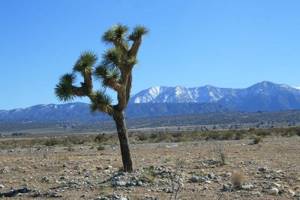
Yucca shortifolia
Yucca elephant
Yucca ivory owes its name to the resemblance of its thick, tree-like stem to an elephant's foot. A distinctive feature of the species is its strong branching. Lanceolate leaves up to a meter in length form a real crown at the top of the yucca. The rosettes are located on short branches, so this plant is very similar to a real tree. There is a thorn at the tip of each leaf. Yucca ivory blooms in the summer, producing panicles 1 meter long, on which large (5 cm) bells are collected.
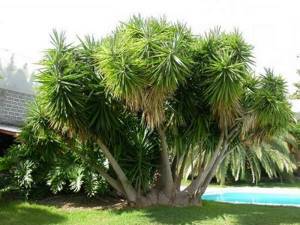
Yucca elephant
Yucca is nice
Yucca gloriousa is native to the southwestern United States. In nature, it grows in the form of a tree up to 2 meters high or a spherical bush. Branching is not typical for this species, and the plant usually has a single woody stem.
The lanceolate-shaped leaf blades reach a length of 60 cm and have a leathery surface. They are painted green with a blue tint. The edges are jagged and end in a spike. Large cream inflorescences on a panicle 2.5 meters high are colored cream with a slight purple tone.
Also read: Causes of drying and yellowing of Dieffenbachia leaves and methods for eliminating them
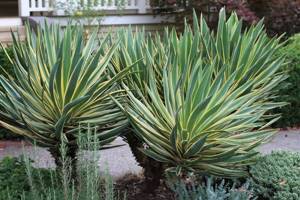
Yucca is nice
Yucca aloefolia
Aloe yucca is found naturally even in Bermuda. This species is characterized by very slow growth, but older specimens are about 8 meters high. Young aloel yucca almost does not branch; all its strength goes to the main trunk. With age, the plant develops crowns located on the side shoots. The length of the fibrous leaves is 50 cm. They are very similar to aloe leaves, which is why this species got its name. There are sharp teeth along the edges, and the very tip is crowned with a spike. The inflorescence is small, its height is only 0.5 m, and the white bell-shaped flowers are purple.
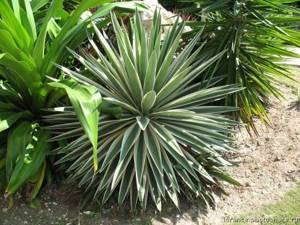
Yucca aloefolia
How to distinguish yucca from other plants
There are many indoor plants similar to yucca. They have long, thin leaves arising from a basal rosette and often a woody trunk.
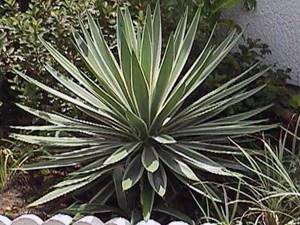
Yucca has hard, serrated leaves with a terminal spine.
If you were given a flower and you don’t know whether it’s a yucca or not, do a little test:
- Run your finger from the base of the leaf to the tip. If the surface is rough, it is most likely yucca.
- The spike at the end of the leaf blade also indicates that the flower belongs to the genus Yucca.
- A woody trunk with a tuft of jagged leaves at the end indicates that this is a false palm.
For comparison: Smooth, shiny leaves with jagged edges belong to pandanus, and a woody trunk ending in a rosette of smooth, thin leaves indicates dracaena.
If you don’t have room for a real palm tree, but really want to have such a plant, plant a yucca. The variety of species will allow you to choose a plant to your liking, and you can keep it in an ordinary apartment.
Main types
As was said, yucca flowers are represented in nature by several dozen species; below are the most common of them, which people use for decorative purposes:
- Yucca aloefolia. This plant is most often grown among the yucca genus by amateur gardeners. When mature, it reaches a height of 1.5 meters, the pointed leaves have a rich green color and are collected in bunches at the top of the trunk. The plant is characterized by magnificent yellow-white inflorescences that appear in the summer. Among the varieties of Yucca aloelia, Yucca "variegata" should be distinguished, which is characterized by light green leaves with cream-colored edges. Aloe yucca is called the “Spanish bayonet” in many South American countries.
- Yucca elephantis, or elephant yucca. It originates from Mexico and Guatemala. This type of plant is called elephant because its trunk expands towards the base and becomes like an elephant’s leg. In the wild, elephant yucca grows up to 15 meters, but in houses its height does not exceed 2 meters. Like Yucca aloe, the leaves grow from the tops of branches or the trunk. The leaves are light green in color and curl as they age. Elephant yucca flowers are white in color.
- Yucca shortifolia. This is a typical desert flower that grows in the wild in the Mojave Desert in the USA (California, Arizona, Utah). The plant has short leaves, which, when collected in bunches, provide an ideal nesting site for some bird species. The peculiarity of this type of yucca is that it can grow for 500 years.
- Yucca "rostrata". This species is native to the desert areas of Mexico and Texas, in particular the Chihuahuan Desert, where "rostrata" can be seen growing in rocky terrain. Of all the types of yucca, it is the “rostrata” that most closely resembles a palm tree due to its characteristic crown and thick trunk. A photo of the Yucca "rostrata" flower is shown below.
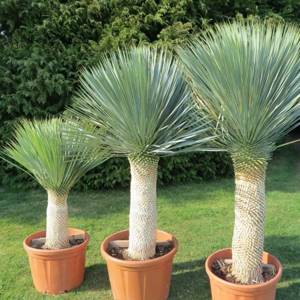
Useful properties of yucca
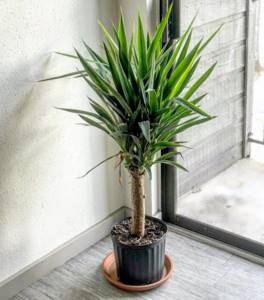
Yucca elephant indoors. Photo
Fibers from yucca, which grows naturally, are used for technical purposes to add durability to denim fabrics. It is used as a dietary supplement in cosmetology. In folk medicine, healing and bactericidal properties are used.
Home plant species create coziness, a peaceful atmosphere, help purify the air and absorb noise. It is believed that peace and prosperity reign in a house where yucca grows. In office buildings, the mysterious flower is grown for good luck in business.
Landing Features
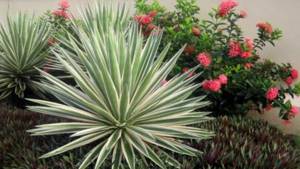
Let's look at this aspect in more detail. Many novice gardeners are interested in how to care for yucca at home. But most of them do not pay enough attention to planting. Despite the fact that there is nothing complicated about this, it is nevertheless important to follow some rules.
Palm trees can grow in almost any soil, but soils with neutral acidity are best suited for growing them. Therefore, the best option would be to buy a special substrate in the store intended for growing yucca. You can also make it yourself. To do this, you need to mix 2 parts of leaf and turf soil, as well as 1 part of peat and humus.
The planting container must be of sufficient size and have high sides. It is necessary to make a drainage system at its bottom. It is necessary for water drainage, since excess moisture is detrimental to yucca. In this case, caring for the plant at home will be simpler.
The drainage from above is covered with nutritious soil, after which the seedling is placed in the pot and sprinkled with substrate. It is worth noting that it is not recommended to deepen the plant too much. For intensive growth and good development, 3 centimeters will be enough.
How to care for yucca until it takes root properly? No special arrangements are required. Regular watering will be sufficient. But you shouldn't pour it too much. You also need to feed the plant periodically.
If you have chosen a variety that has high frost resistance, then after rooting the palm tree can be transplanted into the garden. When keeping a tree outdoors, there is a high chance that it will bloom. But it is necessary to take into account the following important nuances:
- The location for the palm tree should be chosen in such a way that it is well lit and protected from drafts.
- It is best to plant in open ground when the weather is sunny and windless and the thermometer shows 18 degrees.
- Yucca needs nutritious soil. If there is no such thing on your plot of land, then the hole for planting the plant should be at least 50 centimeters deep. It is filled with a mixture of garden soil, peat, humus and river sand.
Yucca flower (care at home is not difficult) is best planted in open ground at the end of spring, when the likelihood of night frosts is completely eliminated, and the temperature outside is consistently at least 7 degrees Celsius. Until this time, the palm tree can be kept indoors or in a greenhouse.
It is recommended to harden the seedling first in order to increase its resistance to adverse factors. To do this, approximately 2-3 weeks before transplanting, the pots with trees are taken outside. Start with short time intervals, gradually increasing the length of stay.
It is not recommended to replant in the fall, especially if you live in a cold region with frosty winters. The tree will not have time to acclimatize and prepare for winter. Even if you prepare good insulation, it will still die.
How to replant yucca at home? This procedure is necessary no more than once every 2 years. If a palm tree has several trunks, then it is better to plant them. This is done using the following technology:
- The trunk together with the rhizome is divided into equal parts.
- The cut areas are treated with charcoal.
- The sprouts are planted in separate containers and watered abundantly.
The plant must first be prepared for replanting. A third of the foliage is removed, and the root system is placed in warm, settled water for several hours. During the work process, you must be extremely careful not to damage the rhizome. Even small breaks can lead to rotting.
If you provide proper care at home, indoor yucca will grow healthy and very beautiful. To do this, it is important to create the most comfortable living conditions. Palm trees have a well-developed root system, so large pots are best for them.
The best option is ceramic products that can withstand any load. You can replant at absolutely any time of the year. But experts advise doing this in the spring so that the tree has time to adapt to the new place before going into winter hibernation.
Features of growing yucca
Since the yucca flower grows in tropical and subtropical zones of the planet, sunlight for it is the main factor for healthy growth, since it not only provides the necessary process of photosynthesis, but also promotes flowering of the plant. There should be a lot of sunlight for yucca, because it is one of the few flowers that needs exposure to direct sunlight. In this regard, it is recommended to place a flower pot in a sunny place in the summer.
Yucca is a relatively unpretentious plant in terms of air temperatures. So, in the summer, 25 °C is the normal temperature for its growth and development. In winter, it is desirable that the air temperature does not fall below 10 °C, so it is better to keep the flower indoors in a well-lit place during the cold period.
Yucca is also unpretentious to cool air currents, which are common if the plant is located outside.
Every gardener who grows a yucca flower should know that in the morning, when the sun is not yet active, it is recommended to spray the leaves of the plant with water from a spray bottle. Such actions are designed to increase humidity near the crown of the plant, simulating the natural conditions of its residence in a tropical climate.
What kind of energy does yucca have and can it be kept at home?
Yucca has a tough masculine character and a strong spirit. These qualities make it possible to clear the room of the energy of people who have a sense of unlimited tenderness, which manifests itself even where it is completely inappropriate. Therefore, if there is such a person in your home or office, you should definitely get a yucca.
Its presence will neutralize the thoughts and doubts of a spineless household member or employee, since its energy brings chaos to the atmosphere of the entire room, while creating unexpected problems for everyone around. People relax, thinking slows down, and even the smartest person often feels like a complete fool. A strong yucca will prevent this from happening, making the surrounding space calm in the home and business-like in the office.
According to Feng Shui, yucca is a symbol of fresh air, purity and perfection. It does not tolerate clutter, and will not bloom in a room that is not constantly cleaned. And if the yucca is blooming, then this, on the contrary, indicates that the space has pure energy, and the people who communicate with the yucca are sincere and honest. According to Feng Shui, yucca should be present near the workplace of a person who often conducts business negotiations and signs important documents.
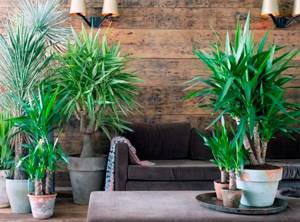
Where to begin?
Let's look at this in more detail. So, you took the plunge and purchased an indoor yucca. The life of a flower in a new place must begin with acclimatization. New conditions are always stressful for the plant.
Immediately after purchasing a flower, experts recommend replanting it in a larger pot and completely changing the soil. It would be good if the new container had high walls. This will allow you to lay a sufficient layer of drainage on the bottom - at least 5 cm.
When transplanting yucca, be sure to pay attention to the soil. You can prepare the soil for the plant yourself, or you can buy ready-made soil at a flower shop. In the second case, it is better to choose special mixtures for dracaenas and palm trees. The soil should have a neutral acidic environment.
If you decide to prepare the soil yourself, then you should adhere to the following proportions: one part humus, two parts sand, two parts turf mixture and leaf soil. It is better to choose sand of a large fraction. This will help ensure the necessary drainage effect.
Before immersing the plant in a container, you need to line the bottom with expanded clay or gravel. The stem should be planted to a depth of no more than 3 centimeters. If the plant is immersed to a great depth, this can lead to rotting and death of the crop.
Brief description of cultivation
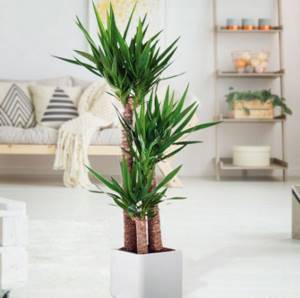
- Bloom . Yucca is grown at home as a large decorative foliage plant.
- Illumination . Needs bright light, which must be diffused.
- Temperature regime . In spring and summer, the plant feels comfortable at a temperature of 20 to 25 degrees; in autumn and winter, the room should not be warmer than 12 degrees.
- Watering . Immediately after the top layer of the substrate in the pot has dried to a depth of 50 mm, the plant is watered abundantly.
- Air humidity . Requirements for air humidity levels depend on the type of yucca. Some species require systematic moistening from a spray bottle, a regular warm shower, and it is also recommended to pour moistened expanded clay into the tray. However, some of the species grow at normal air humidity typical of living rooms.
- Fertilizers . In the spring-summer period, fertilizing is carried out once every 15–20 days; for this purpose, mineral complex fertilizer is used in half the dosage recommended by the manufacturer. The underside surface of the leaf plates is moistened with a nutrient solution.
- Rest period . Not clearly expressed.
- Transplant . It is carried out only if necessary after the root system becomes very crowded in the pot. This procedure is best carried out in the spring, but in the summer it is transplanted only if absolutely necessary. It is not recommended to replant very large bushes, but they need to be replaced every year with the top layer of substrate in the container.
- Soil mixture . The substrate must be neutral with a pH of 6.0–6.5. If possible, it is better to buy a ready-made soil mixture for yucca, and add 30 percent of sand (of the total volume) to it.
- Reproduction . By trunk sections, cuttings and seed method.
- Harmful insects . Whiteflies, spider mites, scale insects and mealybugs.
- Diseases . If the plant is not properly cared for or is not provided with suitable conditions for growth, then its foliage may lose its decorative effect.
Microclimate
This aspect deserves special attention. To maintain the normal functioning of the yucca plant, it is necessary to provide it with a humid microclimate. If the apartment has dry air, additional humidification will be required, for example, using a spray bottle or a special humidifier.
The plant should be sprayed a couple of times a day, especially during the heating season. About once a month, experienced flower growers recommend taking the yucca into the bathroom and giving it water treatments. Using a shower can also wash off accumulated dirt.
How does yucca (palm) grow? Photos of the plant in its natural habitat allow us to conclude that the flower exists in temperate and subtropical climates. In summer, the air temperature should not exceed +26 degrees, and in winter +20. Try to avoid sudden temperature changes caused by open windows. If this condition is not met, the yucca may die in a short time.
Bloom
The yucca flower is shown quite rarely at home, but it looks impressive.
The bell-shaped flowers are borne in panicles or bouquets at the ends of long stalks that emerge from the leaf axils at the tops of stems. The inflorescences are painted white or beige.
Watering yucca
For yucca at home, some drying of the soil is more acceptable than overwatering. Excess moisture, especially at low temperatures, can lead to rotting of the root system and damage to the leaves.
Depending on the prevailing conditions, watering is carried out when the soil has dried to a depth of 5-7cm. The lower the temperature, the less frequent the watering and the lower the liquid consumption:
- in summer - 4-6 days;
- in autumn - winter - 7-10 days.
The consumption of warm, purified water per 5-liter container is a little more than a liter.
Trimming
The palm tree is pruned in order to rejuvenate the plant and give it a beautiful shape. If the yucca is strongly stretched upward, pruning is also carried out.
The procedure is best carried out in the spring, when the plant stops growing. Before trimming indoor yucca, tools must be disinfected with alcohol.
The cut should be completed to the end, and not break off branches with leaves, so as not to touch the growth points. The cut areas must be treated with crushed coal to prevent the process of rotting.
After the operation, the plant is returned to its usual habitat and watered according to existing climate conditions. The cut parts of the plant are not thrown away, but are used for propagation.
Video “Yucca propagation”
What soil is needed for yucca
The soil for yucca requires loose, nutritious, neutral soil with good water permeability. From ready-made soil mixtures, palm soil with the addition of a small amount of coarse sand is suitable for planting it. When preparing the substrate yourself, you can use the following compositions:
- Turf soil - two parts, coniferous soil - two parts, humus - one part, coarse sand - two parts (for young plants);
- Turf soil - three parts, peat soil - two parts, coarse sand - two parts;
- Leaf soil - one part, compost - one part, humus - one part, perlite - one part;
- Garden soil - two parts, crushed pine bark - one part, peat - one part, coarse sand - one part, perlite - one part.
You can add a little crushed charcoal and bone meal to the resulting mixtures.
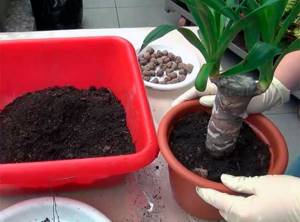
Yucca is a fairly large plant that, with good care, gives rapid growth. Therefore, the pot for planting it must be large and high, each subsequent one increases in volume by about five centimeters. To ensure its stability, in addition to the drainage layer, it is necessary to provide additional weighting by placing granite stones or large pebbles on the bottom. This will prevent the pot from tipping over under the weight of the growing plant.
Wintering
Since this plant is not exactly winter-hardy, it is important to know how to care for yucca in the fall and winter. Yucca varieties grown in our country are frost-resistant and evergreen. However, it is worth protecting the roots from freezing. The filamentous species is frost-resistant, withstands frosts down to -30 °C.
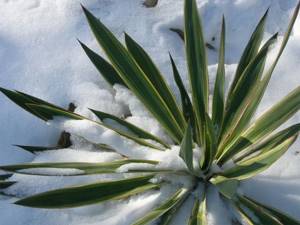
How to cover a yucca for the winter ? After a very cold winter, the plant may bloom less, so its rosettes are sometimes tied with rope for the winter, and the roots are covered with straw or spruce branches. However, some gardeners who tied the leaves from above for the winter discovered that the center of the rosette had rotted.
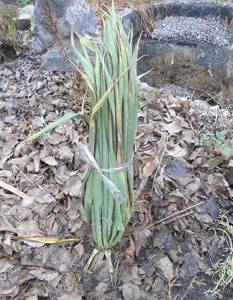
In autumn and winter, the crown of the plant must be protected from precipitation so that water does not get into the middle. In addition, a bush with branched trunks must be protected from moisture in these branches. This can be achieved by making the roof, for example, from a transparent film or glass. Plants will overwinter well under such a roof. It is important that the roof is transparent so that the sun's rays reach the plants. In spring, the roof is removed and the plant is watered so that it begins to grow.
Yucca is very sensitive to stagnant water; you need to make sure that the ground is not too wet, especially in winter.
You can also cover the plant with straw. If the snow layer is too thick, the plant does not have enough light. When snow melts, excess moisture contributes to the appearance of fungal diseases. Excess water can cause rot. Spots appear on the leaves, some (especially the lower ones) dry out.
When the danger of severe frosts passes, the flowers open - in the Moscow region, central Russia, usually at the end of March. Indoor plants should be additionally protected to prevent the roots from freezing.
Reproduction and transplantation
There are the following methods of propagating yucca: sowing seeds, cuttings and propagation by offspring. Yucca is not propagated by seeds in indoor culture. It is very difficult to purchase good planting material, and it is not possible to obtain yucca seeds at home. This plant is usually propagated by vegetative methods.
Tree-like forms of yucca are propagated by cuttings. The material is harvested during formative pruning in early spring.
For propagation, both apical and stem cuttings are used. Cuttings for rooting should be 10-15 cm long and have several leaves and buds. They are cut by making cuts horizontally or at an angle. After cutting, they are dried for 2 hours. Then the bottom of the cuttings is treated with a root growth stimulator and placed for rooting.
You can root yucca at home in water or soil. Only apical cuttings are rooted in water. For these purposes, take boiled water at room temperature. After the roots have formed, the cuttings are planted in a permanent place.
Cuttings of all types can be rooted in the soil. The substrate for rooting yucca is a peat-sand mixture with an equal number of components.
The planted cuttings are covered with jars. You should know that they do not take root well even with a stimulant. Species with a short trunk or stemless are propagated by offspring or daughter rosettes. Young rosettes are cut off with a sharp knife and dried for 2-3 hours. The sections are treated with crushed activated carbon. After this, they are planted in separate pots.
The plant is replanted in early spring and only when necessary. Yucca does not tolerate this procedure well, so it is replanted only if the root system has grown and does not fit in the pot. Transplantation is carried out by transferring it into a larger pot. But the bottom of the new container is laid with drainage made of expanded clay or broken brick.
Typically, young plants are replanted every 2 years. Adult large specimens do not need to be replanted.
The top layer of soil in their pots and tubs is changed twice a year. Tree-like forms of yucca are pruned in March-April to obtain side shoots. To do this, cut off the top of the plant, leaving a stump 20-25 cm high.
The sections are treated with activated carbon. The top is rooted and a new plant is obtained. The stump eventually produces 2-3 side shoots. When the shoots grow sufficiently long, they can also be trimmed to get a beautiful crown.
Seeds
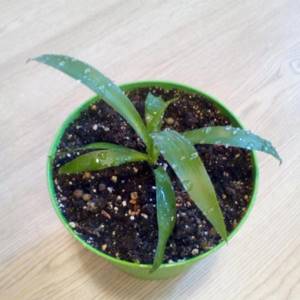
The seeds are sown in a substrate consisting of equal parts of sand, leaf soil and turf, buried by 2-3 cm. The container with the crops is covered with polyethylene and placed in a warm (+25...+30°C) place with bright, diffused lighting, regularly ventilated and watering the soil.
Shoots appear after a month. When 2-3 sheets are formed on them, pick them. Fertilizers are applied 7 days after picking and 2 weeks after that, watering the seedlings with a solution of nitrophoska (1 g per 1 liter of water).
Reference. The planting material is preliminarily scarified - the hard shell of the seeds is slightly damaged with sandpaper for better germination.
Cuttings
Between March and August, the upper part of the plant is cut off with a sharp sterile knife, the cut site is treated with wood ash and dried for 12 hours. Then the cutting is placed in a container with wet perlite, deepened by 3-4 cm.
Rooting occurs in 3-4 weeks. Perlite should be constantly moist, lighting should be diffused, temperature – +25...+30°C.
Part of the trunk
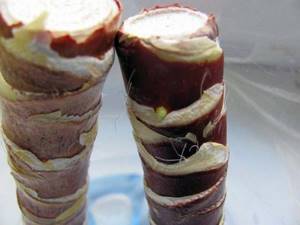
In summer, several pieces of a maximum length of 20 cm are cut from the trunk and planted in a damp peat-sand mixture so that the cut point is at the bottom. Cover the container with film and take it to a shaded place with an air temperature of +20…+24°C. Parts of the trunk take root in 1-2 months.
Caring for yucca at home
Since the homeland of the described plant is the tropics and subtropics, when growing indoors it is necessary to create conditions for it that are close to natural, namely warmth, high humidity, regular access to fresh air and bright lighting.
Did you know? Some peoples, for example, residents of the Dominican Republic, eat the fruits of wild yucca species along with potatoes. They resemble berries with dense, fleshy pulp and are highly nutritious and have beneficial properties.
Lighting and location of the pot
When keeping the tree in a room, you should choose the brightest place. It is better to place it near a south-facing window, shaded from the midday direct rays of the sun. Shading must be mandatory, otherwise the plant's leaves will begin to dry out and sunburn will occur.
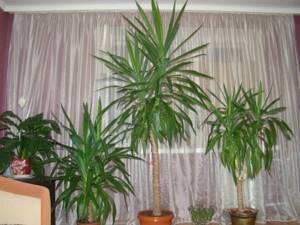
It will also grow well near eastern and southern windows. When grown on the north side, artificial lighting will be required. Additional lighting is also needed in winter. It is better to install fluorescent lamps at a distance of 30–50 cm from the flower. The required length of daylight for yucca is at least 12 hours. If there is not enough light, the leaves of the plant will turn pale and stretch out.
Important! Every 14 days, the yucca pot should be turned 90° so that its ground organs are evenly illuminated. In this way, it will be possible to ensure that the crown is symmetrical.
Temperature
In spring and summer, the plant feels good at temperatures of +23...+25°C. On hot days, it is advisable to take the pot with indoor crops out into the fresh air. In autumn, the temperature must be reduced to provoke the plant to enter a dormant period. It is important to protect the plant from drafts and temperature fluctuations, which can significantly reduce its decorative effect and even destroy it.
Humidity
This indoor crop requires high humidity - 60–70%. The higher the thermometer is, the higher the humidity level should be.
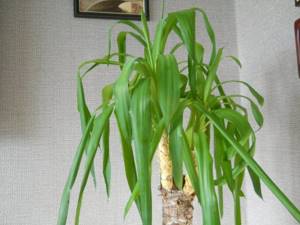
To achieve such conditions, on too hot days and during the heating season, it is necessary to spray the space around the flower with a spray bottle, place the pot on a tray with moistened expanded clay, pebbles, wash it in the shower, or install an air humidifier in the room. At other times, the flower does not require regular spraying. You only need to periodically wipe the sheets with a damp cloth.
Watering
Yucca requires rare but abundant watering. The next moistening should be done when the soil dries 5 cm deep. Watering can be done both from above - under the root, and from below - into the pan. Overwatering and stagnation of moisture are detrimental to the plant, so it is important to ensure that flooding does not occur. If this happens, then you need to dry the soil in a timely manner. The fact that the plant has too much moisture will be indicated by curled leaves and the appearance of brown spots on them.
Moistening the soil must be done with tap water at room temperature, standing for 1–2 days or softened and purified through a filter to remove harmful impurities. Approximately 1 liter of water is required for 5 liters of soil.
Read about ways to propagate yucca at home.
Fertilizing
Yucca does not require frequent feeding. They need to be produced once every 2-3 weeks from spring to September with ready-made universal mineral fertilizers in a reduced dosage. Only feed a healthy tree. A plant with signs of disease or pest damage must first be cured and then, after some time, fertilized. Also, you should not feed a newly transplanted indoor crop - you need to wait for its adaptation to take place.
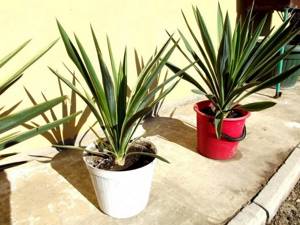
The soil
Yucca should be planted in universal soil purchased in advance from a specialized store. You can also make your own soil substrate.
It is recommended to make a mixture suitable for yucca from the following ingredients:
- turf soil (2 parts);
- sheet soil (2 parts);
- sand (2 parts);
- humus (1 part).
For mature plants, humus is not needed; the amount of turf soil should be increased to three parts. When compiling the soil yourself, it must be disinfected by calcining it in the oven or microwave, pouring it with a solution of potassium permanganate, boiling water, and holding it over steam.
Transfer
Young plants should be replanted annually. Adults - once every few years. It is recommended to replant in the spring. However, yucca easily adapts even if the procedure is carried out in the summer. For replanting, you should purchase a new pot, 2–3 cm larger and corresponding to the size of the root system. The material of the pot is unimportant - it can be plastic, ceramic or a wooden tub.
Read more about how, when and what to properly replant yucca.
The technology for transplanting yucca is as follows:
- The day before the planned procedure, it is necessary to moisten the soil well so that the earthen ball with roots can emerge more easily.
- Place a drainage layer of expanded clay, pebbles, gravel, and brick fragments on the bottom of the pot.
- Sprinkle a small layer of soil on top.
- Remove the yucca from the old pot without destroying the earthen ball.
- Place it in the center of the new container.
- Fill the voids in the pot with soil, leaving 1.5–2 cm to the edge.
- Lightly compact.
- Moisten the soil.
Trimming
Check out
Features of proper pruning of yucca at home This plant definitely needs pruning, which will limit its growth and give the crown the desired shape. It can be produced for the first time when the trunk reaches a diameter of 6 cm.
The procedure is planned for early spring, before the tree begins to actively grow. It is carried out with a well-sharpened knife and disinfected with an alcohol solution.
The trunk is cut so that a tall stump with 2–5 buds remains. The cut area is powdered with activated carbon to avoid the development of rot. In the future, you need to carry out normal care. After 2–3 weeks, the buds left near the cut site should wake up. It is possible to root the cut top and grow a young tree from it.
Features of the rest period
Yucca, like most tropical crops, has a pronounced dormant period, which begins in November and lasts until March. The plant owner needs to take this into account and create all the conditions so that the indoor crop enters winter in a state of “sleep”.
The transition to a period of rest is provoked by two actions:
- a gradual decrease in temperature to +13...+15°C (lowest threshold - +10°C);
- reducing the number and volume of irrigation to a minimum - once every 10 days.
Important! When growing yucca in winter without lowering the temperature, there is a high risk that the leaves will turn yellow and the roots will become rotten.
Starting from October, all fertilizing should be stopped, as this can cause serious harm to the tree. They will need to be resumed only in March or April. In conclusion, we note that yucca is a common indoor crop that requires light, heat, high humidity and simple care. There are several varieties of the tree that differ in size, shape and color of the leaves. The flower looks great when planted alone or in combination with other indoor crops.
Tops

If you provide proper care at home, yucca will grow and develop well. If desired, you can also ensure that the plant has several tips that can be used for propagation. The upper part is carefully cut off. In this case, there must be leaves on it.
The cut area is treated with charcoal. After some time, young shoots should appear on it, and the top is used as a false tree. After harvesting, the cut part is kept in fresh air for two hours, after which it is placed in water or moistened sand. In the first case, the liquid must be boiled and cooled. As soon as the root system is formed in the lower part, the top can be transplanted into a pot or open ground. If during germination the leaves begin to rot, they are removed and the substrate is replaced with fresh one.
General description of plants of the genus Yucca
The name yucca combines a number of tree-like plants with linear-lanceolate leaves with sharp ends arranged in a spiral, clustered at the top of the trunk or shoots. They reach a length of up to 1 m. Their stem is not too high, it can be without branches or with them. There are types in which it is very low and inconspicuous.
Did you know? Yucca is also called the denim tree. The plant received this name because fabric material was previously made from its fibers. Today, some manufacturers add these fibers to denim to improve durability.
Most yucca species have a bush-like appearance when young. Subsequently, as the trunk develops and grows, the lower leaves fall off, as a result of which the trunk below becomes bare. In its natural environment, the plant blooms with large white bell-shaped flowers. They are united into a long panicle, which can reach a length of up to 2 m.
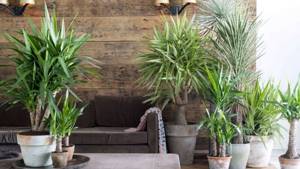
Flowers grow hanging on short stalks. Flowering occurs in summer. At home, flowering is a rare occurrence. After flowering, yucca produces fruits in the form of a box or berries. When grown indoors, yucca resembles a false palm. It can grow up to 4 m.
Possible difficulties
Plant death is often caused by either too much watering in winter or too low a temperature. If, due to excessive moisture in the substrate, the roots of the yucca began to rot, and dark spots and softened areas appeared on the trunk - but at least a few leaves and part of the trunk remained light in color, hard and elastic to the touch, then you can try to grow new roots from the affected plant in two ways :
1. Rooting a healthy part of a yucca trunk using air layering. On the living part of the stem (at least 10-15 cm above the rotting part, and no lower than 60 cm from the top), remove the bark with a sharp knife in a “ring” 0.5 cm wide. At the place where the bark was removed and a little higher, the trunk is tied yucca with damp sphagnum moss, and on top of it with plastic film so that the moisture does not quickly evaporate from the moss. The moisture of the moss should be constantly maintained, if necessary, wetting it with a spray bottle. After 2-3 weeks, the plant usually develops new roots above the area where the bark was removed. The roots are grown for another two weeks without removing the moss and film from them. When the new yucca roots grow and branch, the upper part of the plant with the new roots is cut off below the point where the bark was removed. The cut is sprinkled with crushed coal, slightly dried and the plant is planted in a new pot with fresh substrate. The soil should consist of garden or humus soil and coarse sand (at least a quarter of the total volume of soil).
2. Rooting a healthy part of a yucca trunk in a mini-greenhouse. Using a sharp knife, cut off the living part of the plant from the rotting part. It is desirable that the length of the resulting cutting be no more than 30 cm, and the remaining living part of the trunk can be rooted separately. The cut of the cutting is sprinkled with crushed coal, dried a little and the cutting is planted in a pot with wet coarse sand. To ensure increased air humidity, cover the top of the cutting with a large jar or set up a mini-greenhouse: stick 3-4 thin sticks vertically into the pot with the cutting so that they are higher than the cutting itself, and cover the pot with the cutting with a transparent plastic bag, tying its edges potty The renewed plant takes root in a month and a half; It is important not to over-moisten the soil, but also not to let it dry out.
Yellowing lower leaves - if the leaves turn yellow slowly, this is natural and inevitable for older plants. Yucca plants tend to have green leaves only at the top of the bare stem. This appearance is explained by the fact that their leaves do not live long; after two years they turn yellow and die.
When transplanted or purchased, the plant may also shed some of its lower leaves ; this is a natural reaction to changing conditions. If this is widespread, hypothermia or drafts are possible.
Brown tips or edges of leaves indicate dry air. Most yuccas require high humidity. Other causes could be cold drafts or insufficient watering.
Brown spots on the leaves - insufficient watering. The earthen ball should be wet all the time.
Soft curled leaves and brown edges indicate too low a temperature. Delicate species exhibit similar signs if left near a window on a cold night.
Light dry spots on the leaves - too much sun.
Grayish-brown spots on leaves (leaf spot). A fungal or bacterial disease caused by high humidity in the air and soil. Affected leaves must be removed. Spray with a systemic fungicide, reduce watering and stop spraying.
Rot of stems. A disease caused by a fungus. Part of the stem or crown becomes soft and rots. A fungus that infects a plant usually develops quickly and, as a rule, the entire plant dies. Waterlogged soil and poorly ventilated areas promote the development of fungus. In the initial stage of the disease, you can try to save the plant by removing all affected tissue. In case of serious damage, destroy the plant along with the soil and pot.
What to do if the yucca turns yellow?
Everything is possible, there is no reason to worry. As the plant grows and matures, its lower leaves fall off. This is a natural process. But if the yellow spots on the leaves turn brown or take on an elliptical shape, then the plant may have a fungal disease. It needs to be treated and attention to watering and room temperature. Drafts and too wet soil can lead to root rot, fungal diseases and plant death. Keep in mind that it is better to underfill yucca than to overfill it!
Light spots
appear in low light conditions.
Curling leaf tips
they say the room temperature is too low.
White spots
- These are sunburns. The flower pot needs to be moved to partial shade.
Dry brown spots on leaves
the tree is reported to need more frequent watering. The flower is watered rarely, but the earthen lump should not dry out completely.
Yucca leaves falling
. After transplanting or changing the place of “residence” (after purchase), some of the leaves may fall off. If the leaves have drooped and fallen almost completely, the tree may be in a draft and its roots have become too cold. Leaves may also fall because the flower grows in soil that is always wet. In this case, the roots will begin to rot, the yucca’s trunk and shoots will become soft, the leaves will droop and begin to fall off. Remember! The soil should have time to dry out between waterings! If the room is cool, then watering should not be too frequent.
Diseases and care problems
You can tell that something is wrong with a plant by its appearance. Here are a few signs that will tell you what needs to be adjusted in your care.
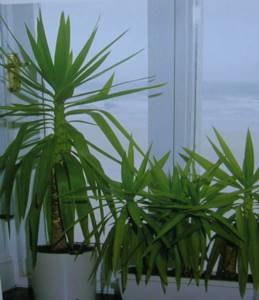
Yellow leaves. If only the lower leaves turn yellow, and the upper ones remain green and look healthy, there is no need to worry. This is a natural process.
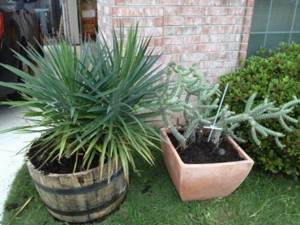
Discoloration and dropping of the top leaves can occur due to stress. This usually happens after a move or a sudden change in living conditions.

The tips of the leaves dry out. The reason is lack of moisture, drafts, dry air in the room.
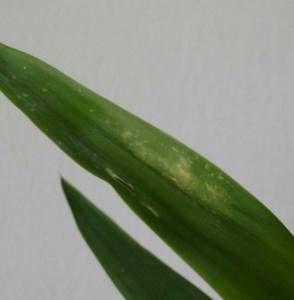
Brown spots on leaves. The plant lacks moisture. Most likely, the earthen lump has time to dry out completely between waterings, which should not be allowed.
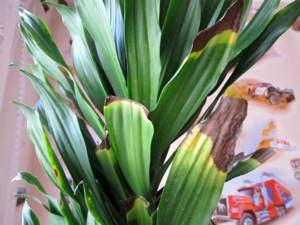
The yucca leaf curls. The reason may be low night temperatures when the plant is not removed from the cold room in time.
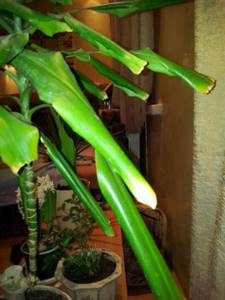
Among the pests on indoor yucca you can find spider mites, scale insects, and mealyworms. You can get rid of them using special means and wiping the leaves with soapy water.
